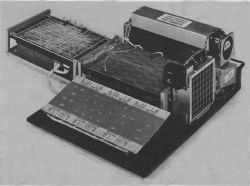IBM got their PCs and PS/2 computers into schools in the 1980s and 1990s. We fondly remember educational games like Super Solvers: Treasure Mountain. However, IBM had been trying to get into the educational market long before the PC. In 1969, the IBM Schools Computer System Unit was developed. Though it never reached commercial release, ten were made, and they were deployed to pilot schools. One remained in use for almost a decade! And now, there’s a new one — well, a replica of IBM’s experimental school computer by [Menadue], at least. You can check it out in the video below.
The internals were based somewhat on the IBM System/360’s technology. Interestingly, it used a touch-sensitive keypad instead of a traditional keyboard. From what we’ve read, it seems this system had a lot of firsts: the first system to use a domestic TV as an output device, the first system to use a cassette deck as a storage medium, and the first purpose-built educational computer. It was developed at IBM Hursley in the UK and used magnetic core memory. It used BCD for numerical display instead of hexadecimal or octal, with floating point numbers as a basic type. It also used 32-bit registers, though they stored BCD digits and not binary. In short, this thing was way ahead of its time.
[Menadue] saw the machine at the IBM Hursley museum and liked it so much that he proceeded to build a prototype machine based partially on a document shown at the museum that showed the instructions. Further research revealed a complete document explaining the instruction set. The initial prototype was made on a small PCB with a Raspberry Pi Pico W, an OLED display, and key switches, which proved that he understood the system enough to replicate it.

After that prototype, work began on the replica. It’s a half-scale model, but it does use a touch keyboard like the original. The attention to detail is nice, with the colours of the case matching and even a small IBM logo replica on the front! It’s made from a metal chassis, with the keyboard surround being plastic (as on the original) so as not to interfere with the touch keyboard. It’s programmed using the same set of instructions as the original — a combination of low-level commands, similar to assembly for microprocessors, but with an extra set of slightly higher-level instructions that IBM called Extra Codes. For a more in-depth explanation, check out the video going over the original system and the prototype replica!
Photos courtesy of IBM Hursley Museum
















Wow. My dad worked on education software at IBM in the late 60s and he never mentioned this. Pretty advanced for 1969.
I wonder how many wrong numbers were keyed in with that variation on the Bell Handicap number pad? Worse than zigzag cells in a battery holder.
Wonder how home computer history would differ if this had made it into schools?
It did make it into schools, but in a limited way. There’s a photo here:
https://www.stedwardsarchives.org/PDFViewer/web/viewer.html?file=%2fFilename.ashx%3ftableName%3dta_Publications%26columnName%3dfilename%26recordId%3d685%26zoom%3dpage-fit&searchText=schools%27%20computer
of it being used in a classroom. It did have a small effect on the history of computing:
https://www.cs.cmu.edu/~popl-interviews/peytonjones.html
Good grief!! That takes me back! The date in the St Edward’s article is wrong. I went there in ’68 and the computer didn’t arrive until at least a year later
I think that photo was taken at a school science fair at Oxford Poly (now Brookes) probably summer 1970
Hi James,
I’m writing about beginnings of computing education in England at the moment. I also had the IBM machine launching in 1969, as per the Hursley website. Are you sure that Tinsley got it wrong?
The school magazine has it appearing in Autumn 1967?
https://www.stedwardsarchives.org/PDFViewer/web/viewer.html?file=%2fFilename.ashx%3ftableName%3dta_Publications%26columnName%3dfilename%26recordId%3d602%26zoom%3dpage-fit&searchText=ibm
Hi James, good to see you around after so long! This thread only mentions the 10 production models, but there was also a prototype (a large box with separate keyboard) which our school had for a few weeks about a year earlier. I do still agree with you, David Tinsley has got the date wrong in our school magazine. Tony
Does not seems to have much info in the original. What is it run … how can it store the system … data … cassette type for dos/360 with user input ?
It doesn’t run an operating system as such, you program instructions in machine code. The system code and user code is store din core store, which is non volatile. The ‘extracodes’ can be altered by the user, so new instructions could be, and were implemented. You could, if you wanted to, replace all of the extracodes in the system. The memory could also be stored and loaded onto and from cassette tape in a proprietary format. These are normal domestic tapes in a domestic cassette player.
I’m not sure what dos/360 is. The unit used electronics of the same form as the IBM 360 but no code from the 360.
This is the document that explains the instructions:
https://ibmhursleymuseum.info/hursley/IBM%20Hardware/Schools%20Computer/Schools%20Documentation/schools%20-%20concepts.pdf
and this is the reference card that summarises the instructions:
https://ibmhursleymuseum.info/hursley/IBM%20Hardware/Schools%20Computer/Schools%20Documentation/schools%20-%20ref%20card.pdf
The only programs I know of for this machine are in this document:
https://ibmhursleymuseum.info/hursley/IBM%20Hardware/Schools%20Computer/Schools%20Documentation/A%20First%20Course%20on%20the%20Schools%20Computer%20215-8017-0.pdf
and these flowcharts:
https://ibmhursleymuseum.info/hursley/IBM%20Hardware/Schools%20Computer/Schools%20Documentation/Schools%20Computer%20flowcharts.pdf
I remember we were very lucky to have one at Leith Academy. Our maths teacher Mr John Young ran a computer club which took place after school. I enjoyed the machine code programming but also wrote a small compiler from a new language I called SALT for Simple Algorithmic Language Translator written in Fortran which ran on the Moray House College IBM computer.
Hi Ken, Do you know what year this was? How long did Leith have it for? I didn’t realise any went to Scotland. Was the machine on site, or loaned out from Moray House.
Am I correct in saying that SALT was a preprocessor for School’s Computer programs? If so, OI don’t suppose you still have any notes on it, or can remember what it was like?